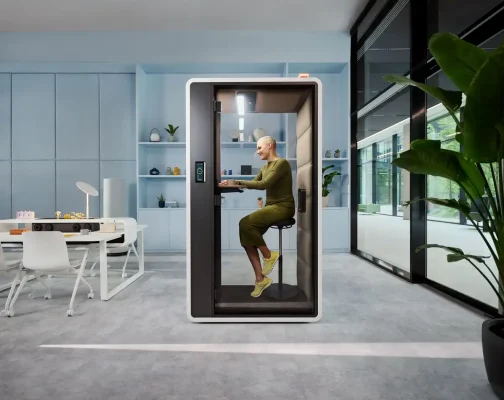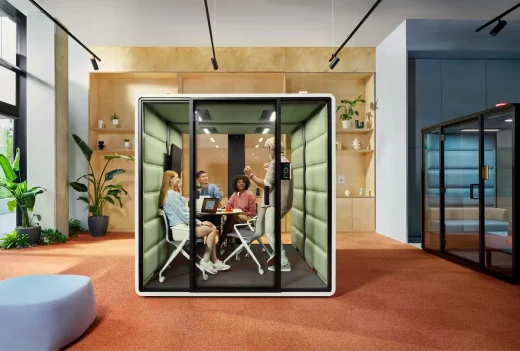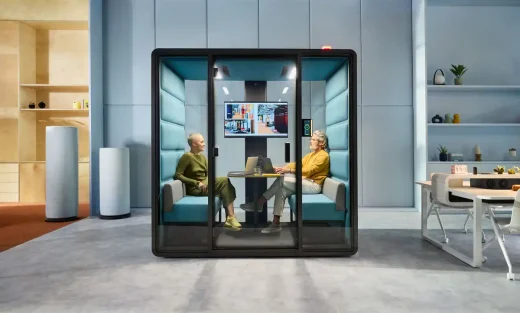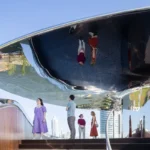Third places as a break-away from run-of-the-mill offices tips, Commercial property interior
Third places as a break-away from run-of-the-mill offices?
17 February 2025
It is time to redefine our understanding of the office. Can a workspace be more than a set of desks and meeting rooms? In the age of hybrid working and the growing importance of employee wellbeing, more and more companies are looking for innovative solutions that not only improve efficiency but also create an inspiring work environment. ‘Third places’ are one of these. In this article, we will look into third places and to find out the benefits they bring to employees and companies.
What exactly is the third place?
Third place is a sociological concept that was first introduced by Ray Oldenburg in his 1989 book The Great Good Place. He defined three key spaces in people’s lives: home as the first place, work as the second one, while the third place is a public space that plays an important role in social life. It helps strengthen interpersonal bonds, fosters community building, provides emotional support and a sense of belonging. Third places are also those where new ideas and initiatives are born.
A study by Swinburne University found out that almost 50% of people who work remotely spend part of their working day in what is called a third place [1]. These spaces offer an alternative to the home office and the formal work environment. A café, library, park or coworking spaces let hourly could be third places as well. These locations, especially if they have an internet access, attract employees looking for a social environment that encourages interaction during their work.
What do employees look for in a workplace?
High competition for the best employees is forcing companies to commit to attracting and retaining talent. For many young people, the looks of office spaces is one of the important factors in their decision to join a particular place. As organisations seek to diversify their work environment, they are focusing on better understanding staff demographics and values.
The perks provided may include local food and entertainment, pet care and free parking. But amidst all these solutions, there is one factor that remains at the forefront of most contemporary workplace designs: the need for human contact. Although younger employees represent a generation that has grown up in the age of social media and is proficient in virtual collaboration, there is still a strong desire to build face-to-face relationships and nurture personal contact.
How do you design an attractive office that competes with third places?
Employees are attracted to an environment where they can work, socialise and simply be themselves. For this reason, companies put more and more effort in designing office spaces that encourage people to choose stationary over remote work styles.
Third places in the office attract people and encourage them to take a short break. Third places work as a social magnet for employees to get out of the ‘business only’ mentality and engage in more informal interaction. They help build community and stimulate new ideas. These spaces are different from formal meeting rooms – they are neutral ground.
The most effective third places are inspired by hotels, lounges and restaurants – places commonly associated with relaxation and socialising. Also, the proper design of office spaces provides for aspects such as warm lighting or integrated amenities, including Hushoffice multi-person acoustic pods. When employees break away from their strenuous work and enter a bright, refreshing room, their minds switch over to a state making them more capable of creative thinking, generating novel ideas and networking.
Does an office alternative to third places have to be expensive?
Re-arranging an office does not have to mean costly refurbishment for companies. They can simply identify the already interactive areas and modify these spaces to be more welcoming. Lounge areas and hushSpot table collaborative zones encourage human interaction. The size of the space is less important than the quality of what is happening in it. The hushFree.M acoustic pod will provide a hushed space for relaxing over a cup of coffee or chatting with up to 4 people. The change of scenery will allow teams to take a break from desk work.
When will acoustic pods work better than third places?
Not all projects can be worked on efficiently and satisfactorily in third places. Activities that require silence, such as important phone calls or video conferences, acoustic pods offer the isolation that is lacking in open, public areas. Innovative larger office booths such as hushFree.L are spaces to use in a way down to your discretion. Changing the environment becomes a matter of a few steps.
This eliminates the need to travel to cafés or other third places, thus saving time. Office pods are also becoming a stable haven in the office, as you can quickly enter to rest inside when overstimulated or when you need to focus on tasks that require deep concentration. What’s more, the booths can be booked so that their availability is guaranteed, whereas third places can be crowded. Acoustic pods placed in the open space provide comfort and independence, as they combine the advantages of third places with the functionality of professional workspaces.
[1] https://www.swinburne.edu.au/news/2023/01/Youre-about-to-see-a-growing-trend-of-laptop-workers-in-cafes-new-research-reveals-why/
Comments on this guide to Third places as a break-away from run-of-the-mill offices? article are welcome.
Office Property Design
Office Property Refurbishment and Designs
Third places offices break-away
How to give your office a modern makeover
Office Furniture Design
Office chairs and how to choose the best
Office Furniture Trends for 2023
Property Articles
Residential Architecture
Comments / photos for the Third places as a break-away from run-of-the-mill offices? page welcome








